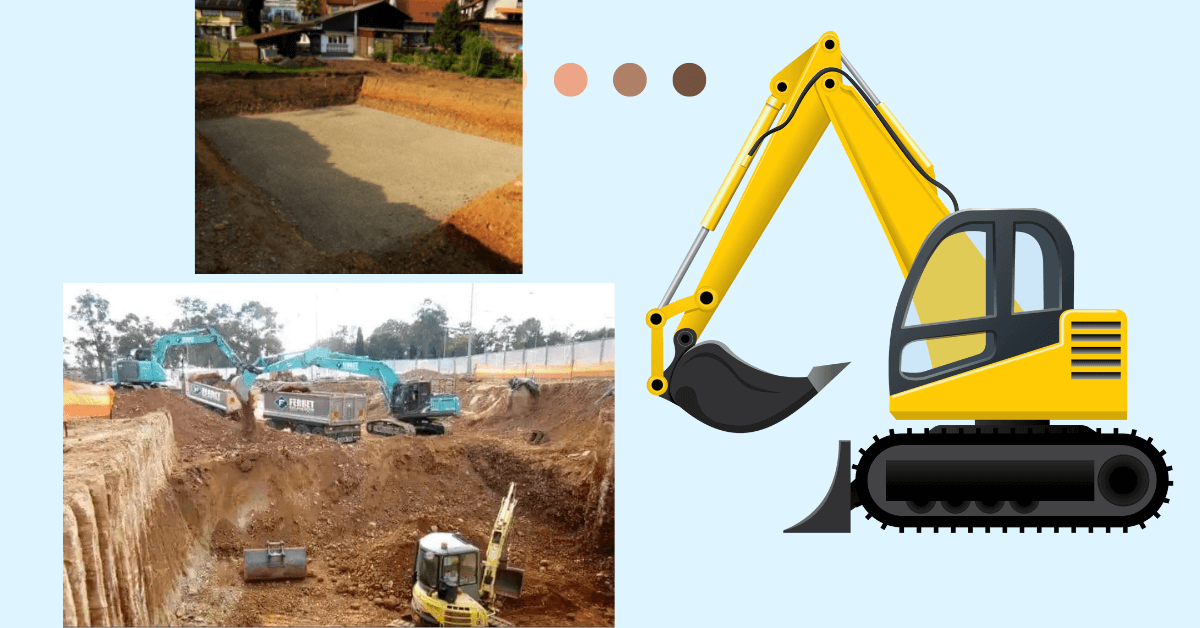Well you want information about house excavation or excavating. I would answer excavation related questions in building construction.
What is excavation or excavating?

Excavation is the action of digging and removing soil material from the ground. Excavation covers all types of open cuts in the ground irrespective of their size or type.
What is a trench excavation?
According to OSHA “A trench is defined as a narrow excavation (in relation to its length) made below the surface of the ground. In general, the depth of a trench is greater than its width, but the width of a trench (measured at the bottom) is not greater than 15 feet (4.6 m).”
Normally during excavation machinery is used. However, if the excavation volume is very small it is economical to excavate digging by hand or manually. The type of machinery depends on the type of excavation that is to be done.
Generally, there are three types of excavation.
- Topsoil removal
- Shallow excavation
- Deep excavation
Topsoil removal or shallow excavation may be done manually but deep excavation is executed only by machinery.
For topsoil removal, bulldozers are usually used. Bulldozers are heavy machinery that are utilized to remove the top part of the ground such as unsuitable soil, vegetation, or waste material. For shallow and deep excavation, normally, excavators are utilized. Excavators are heavy construction machinery that can excavate in depth.
One of the essential steps of house construction is excavation. Excavation work goes hand to hand with the construction of the foundation of buildings. The construction of a building’s foundation is the most significant construction work in the implementation of building projects. But why?
It is because the foundation supports all the weight of the building. It is also susceptible to the encroachment of water into the building. And water is the main enemy of the health of the house.
Quality and safety of the excavation
Excavation and trenching are one of the most hazardous construction activities. Therefore, there are regulatory norms imposed by cities to control their proper implementation. The standard which is applicable in the USA is the OSHA standard.
The OSHA standard specifies the difference between excavation and trenching. According to OSHA excavation is any open cut on the ground. However, a trench is a narrow excavation in relation to its length with a width of excavation of less than 15ft(4.6m) and generally, the width of the trench is less than the depth of excavation.
Standards such as OSHA are applied in order to ensure that the work environment is safe for workers and property. OSHA recommends that work should be preplanned in order to avoid operational interruptions during excavation and the possibility of hazards.
The tasks that are to be performed by the competent person include Classifying soil; Inspecting protective systems; Designing structural ramps; Monitoring water removal equipment; and Conducting site inspections
Cave-ins pose the greatest risk for workers, but necessary measures should be taken also for hazards of falling loads, unsuitable atmosphere, and mobile equipment.
For further reading, we recommend EXCAVATION SAFETY | RLS HUMAN CARE (rlsdhamal.com)
Type of excavation safety hazards
- Cave-ins: The sides of the excavation fall into the excavation area.
- Falls and falling loads: equipment falls into the excavation area
- Hazardous atmospheres: The atmospheric air composition is dangerous to human life.
- Mobile equipment.: Nearby equipment operations pose danger to workers
- Hitting utility lines: The utility lines can be damaged risking workers’ life
OSHA specifies how to classify soil type since the type of the soil determines what measures should be undertaken before and during excavation. The soil is classified into four types according to its geotechnical properties. Stable rock; Type A soil; Type B soil; or Type C soil. If compliance requires a competent person should be responsible for identifying soil types.
Especially when there are building nearby and underground structures such as foundations or public utilities, there is a risk of hazard of the excavation. Hence, OSHA standards should be followed carefully, and if necessary competent professional needs to be involved in the projects for planning the excavation.
Is there a type of excavation that does not need special measures? Yes. OSHA standard specifies that the excavation is safe and does not need special measures, such as for stable soil such as rock or when there is no risk of excavation when the excavation is less than 1.55m.
How to calculate excavation volume
The volume of excavation is calculated as:
Volume= L*W*D,
L: Length of excavation
W: Width of excavation
D: Depth of excavation
Use the online volume of excavation calculator below:
[CP_CALCULATED_FIELDS id=”7″]
Cost of excavation
The cost of excavation depends on the soil, depth of excavation, topography, environment, type of equipment, manpower, the distance of soil disposal, and location.
The total cost of machinery, manpower, and hauling of disposed soil is calculated per unit volume of soil excavated.
Since the cost of excavation depends on the depth, the cost is calculated for the selected intervals of depths such as below.
- For depth up to 1.5m
- For depth between 1.5m to 3m.
- For depth between 3.m to 4.5m.
- For depths more than 4.5m
Further, the cost of excavation needs to be categorized per the distance of hauling of disposed soil and therefore the costs shall be categorized in the depth of excavation and hauling distance.
You can refer to the sample excavation calculation cost that is prepared in the excel sheet.
Nowadays it is common to use cost estimation software such as Autodesk’s proest.
If you want preliminary cost estimates or free cost estimates, you can check the following websites.
If the location is in united states
https://porch.com/project-cost/cost-to-excavate-land
https://www.fixr.com/costs/land-clearing-and-building-site-preparation
If the location is in the UK
https://householdcosts.co.uk/excavation-cost/
If the location is in the Australia
https://www.hiretrades.com.au/cost-guides/excavation/how-much-does-excavation-cost
https://www.oneflare.com.au/costs/excavation
https://hipages.com.au/article/how_much_does_excavation_cost
If the location is in Canada
https://excavation.homeblue.com/cost/Estimates-Excavation-Contractors.aspx
For other locations such as Italy, Netherlands, Germany, and others
https://www.homeadvisor.com/cost/landscape/excavate-land/
Methods of excavation
The method selected for a particular excavation type is selected on several factors that affect the stability of the excavated slope. The aim of the choice of excavation method is to ensure that the excavation is stable and cave-ins are avoided.
In the case of stable rock or when an excavation is less than 5 feet (1.52 meters) deep does not require a protection system if a competent person has verified that there is no risk of a potential cave-in.
For further information refer OSHA’s technical manual
Sheet pile
These are long structural elements that are made mainly from steel but can be also made from concrete or timber. Sheet piles are used to retain soils or water.
They are a popular method of protection in deep excavation. Sheet piles transfer the pressure from the soil or water to the base support which is embedded in the soil or to anchors that are buried in the adjacent soil.
Benching excavation
In benching excavation, the sides of the excavation of soil is provided with series of steps or horizontal levels. Benching is not viable for OSHA’s type C soils.
Sloping excavation
The sides of the excavation are provided with suitable slopes for preventing cave-ins. The sides of the excavation are sloped to an angle not steeper than 1½:1 (for every foot of depth, the trench must be excavated back 1½ feet). This slope is safe for any type of soil
Shoring excavation
Shoring is the process of temporarily supporting a building, vessel, structure, or trench with shores (props) when in danger of collapse or during repairs or alterations. Shoring comes from shore, a timber or metal prop.
Shielding
Shielding is a protection system of workers by using trench boxes or other types of supports to prevent soil cave-ins.
If you want a guide on how to build a house foundation step by step check our article. You can also check our foundation calculators. |

